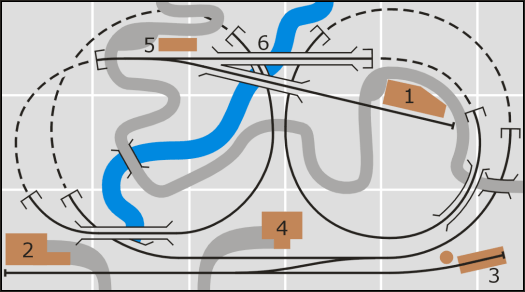Window Display Layout
As an example of realistic modeling, this layout was not a contender by any stretch of the imagination, but as a hobby shop display, it was a winner. It had a number of features that would catch the eye of passers-by, particularly a convoluted track plan that would keep kids (and even some adults) guessing where the train would emerge next. The rugged scenery featured a waterfall and lots of roads populated by Märklin's early solid rubber automobiles.

Although it had no name, the railroad did have an agenda: to ship spring water in tank cars from a mountain spring (1) to a bottling plant (2). The only other structures were the enginehouse (3) and two passenger stations (4 and 5). All of the structures were scratchbuilt, and except for the long bridge at the top of the plan (6), which was Märklin's arched steel truss, all of the bridges were scratchbuilt as well.
Scenery was quite strange: I decided to try using Plasticine (a modeling clay that never hardens), which I applied in a roughly half-inch-thick layer over a cardstock support structure. While it did offer some unique advantages—for instance, I could simulate stone by pressing a small screwdriver into the clay, and plant trees as quickly as I could pop them into the landscape—Plasticine had as many negative qualities, including excessive weight and an objectionable odor. It was, nevertheless, an interesting experiment.
Another experiment was a way to ballast the track without applying loose material or glue onto the track, which I was certain would cause problems, especially for Märklin's delicate turnouts. Back then, Arnold Rapido used to sell a ballast-like material made from ground cork. I painted the cookie-cutter Homasote roadbed with thick dark gray acrylic paint, then sprinkled the cork onto the wet paint. When it was dry, I vacuumed away any excess and then attached the track with straight pins; the cork compressed under the track, giving it a more fully-ballasted appearance.
 The layout could be powered
either by household current (using a doorbell transformer), or by a 6-volt lantern battery, and a miniature tethered handheld unit
controlled everything, including the throttle, lights and turnouts. For those with an extensive collection of old Model
Railroader magazines, you can see photos and read "A World in My Lap," an article I wrote about this layout, in the
October 1975 issue; this is thought to be the first article on Z scale published in this magazine.
The layout could be powered
either by household current (using a doorbell transformer), or by a 6-volt lantern battery, and a miniature tethered handheld unit
controlled everything, including the throttle, lights and turnouts. For those with an extensive collection of old Model
Railroader magazines, you can see photos and read "A World in My Lap," an article I wrote about this layout, in the
October 1975 issue; this is thought to be the first article on Z scale published in this magazine.
Ultimately, the fate of the layout was determined by attendees of model railroad convention at Princeton University in the late 70s, where the layout was put on display. Owing to a bad back, I was unable to be present, but I was assured by others that the layout would be carefully guarded. Sadly, this was not the case; when the layout was returned to me, it was badly damaged. People had poked their fingers right through the scenery, torn out trees, and generally made a mess of it; adding insult to injury, a locomotive and a couple of cars had been stolen. I was too depressed by this to make repairs, so I dismantled the layout. It was a painful lesson to learn: never trust anyone, even modeling colleagues.
Copyright © 2007-2013 by David K. Smith. All Rights Reserved.
